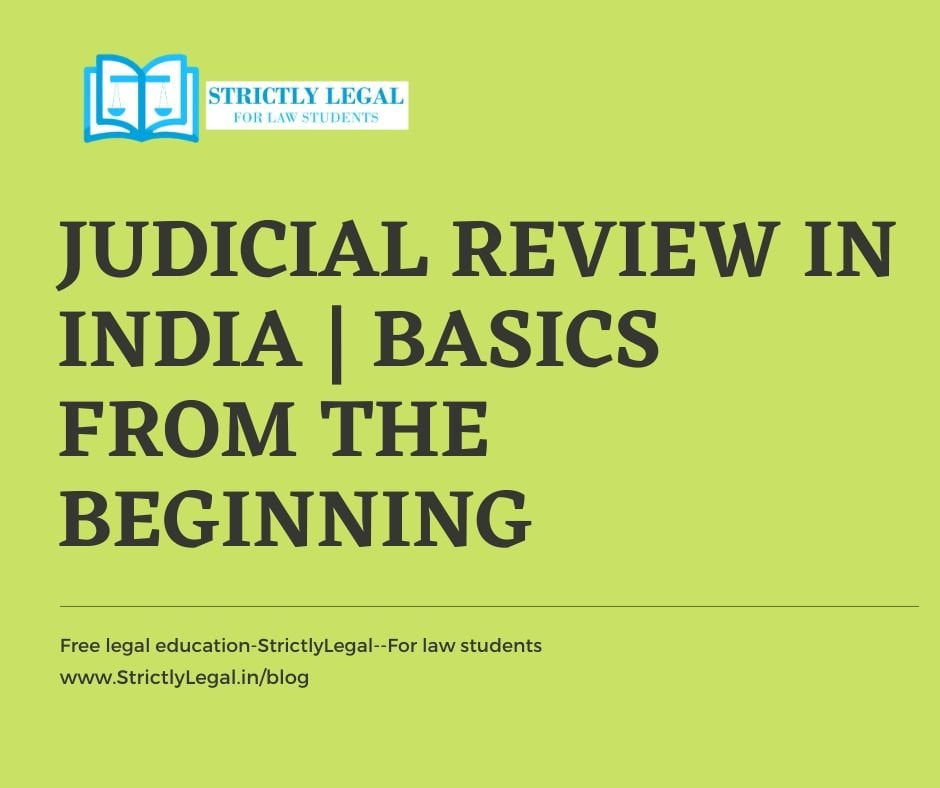In this article, we will discuss Judicial review, an important tool that is used for checks and bounces to ensure proper adherence to the constitution. This tool is not only used in India but in many countries including the United States of America from where it was originally propounded i.e the Marbury v Madison case in 1803.
Table of Contents
What is Judicial Review?
One of the core principles embedded in our constitution itself is that there’s no other law in the land superior to the Constitution of India.
The framers of the Indian constitution made a logical separation of powers amongst three heads i.e the running of the country can be broadly categorized into three functions namely:
- The Legislative i.e the rulemaking body
- The Executive i.e the rule implementing body.
- The Judiciary i.e the rule interpreting body.
These funtions under the Constitution are independent of each other to ensure that there’s no concentration of power in any one hand.
Now, Judicial Review is a way of safeguarding the constitution against the hands who want to overturn the constitution for their own advantage. In simpler terms, the judicial review helps strike down any law, order, or activity of the legislature, executive, or for that matter any administrative body that is unconstitutional in the view of the judiciary.
Any act of the ordinary law making bodies which contravenes the provisions of the supreme law must be void and there must be some organ which is to possess the power or authority to pronounce such legislative acts void.
Basu in his book Basu’s commentaries on constitution of india, vol 1.
Features of Judicial Review in India
- The power of judicial review rest with the Supreme Court and High Courts. The review by the high court can be improved or deleted by the supreme court. The final power rests with the Supreme Court.
- Judicial Review can be conducted overall central and state laws including amendments to constitutional law.
- The Courts do not have the power to take cognizance of matters for judicial Review on its own that is no power to suo moto cognizance. It has to be directly challenged or through the course of a hearing.
- If through judicial review the court finds that law is invalid on the grounds of it being unconstitutional, it has the power to struck down the law as a whole or only remove the invalid power if the remaining part is able to give force to the legislature’s intent. (Read: Doctrine of Severability)
- The judgments are in effect from the date of it is passed under Judicial review.
- The principle of Judicial Review falls within an Integral part of the Constitution of India. [R. Coelho v. State of Tamil Nadu]
- However, one limitation is that no judicial review can be done on matters enlisted on the 9th schedule of the constitution. The 9th schedule to the Indian Constitution currently lists 284 such central and state laws that are out of the purview of the judicial review.
Why is the 9th schedule excluded from Judicial review?
The nineth scheule to the Constitution of India contains as many as 284 laws from the center and state that are out of purview of the Judicial Review.
31B. Validation of certain Acts and Regulations Without prejudice to the generality of the provisions contained in Article 31A, none of the Acts and Regulations specified in the Ninth Schedule nor any of the provisions thereof shall be deemed to be void, or ever to have become void, on the ground that such Act, Regulation or provision is inconsistent with, or takes away or abridges any of the rights conferred by, any provisions of this Part, and notwithstanding any judgment, decree or order of any court or tribunal to the contrary, each of the said Acts and Regulations shall, subject to the power of any competent Legislature to repeal or amend it, continue in force
Article 31B, Constitution of India
Why was there a need for Judicial Review?
- India has a written constitution and words can have different meanings. The problems of interpretation are bound to arise.
- In a big democratic country like India, even a minor body of the government has to take decisions on a regular basis. It is important that these decisions are taken in the best interest of the citizens of the country and which are abided by the constitution. Judicial Review by the courts work as a check on these decisions.
- To protect the right of the citizens, the court have to be the protector of the rights of the citizens. It is the core function of the judiciary and tools such as these help in the process.
History
The term has evolved ever since its first use in Marbury v. Madison’s case in 1803 in the Supreme Court of the United States.
In the case of Marbury v. Madison, it was held that it is the power of the federal courts to announce legislative and executive laws or acts as invalid if they violate the Constitution.
Watch an animated video explaing the Marbury v. Madison’s case
Judicial review today remains one of the powerful and well-established tools of the courts and has been described as “America’s original contribution to the science of law.”
Three Aspects of Judicial Review
In India especially, Judicial Review can be categorized into three heads:
- Administrative Actions
- Legislative Actions
- Judicial Actions
We will deal with the first aspect on this post.
Judicial Review of Administrative Actions
Administrative actions may refer to residuary actions which are neither legislative nor judicial. There are minor differences between executive and administrative, you may want to refer to a dictionary for that. I have taken a broad perspective on administrative actions as a whole here that includes executive actions as well.
As has been laid down in Council of civil Services Union v. Minister of Civil services Generally, Judicial Review in Administrative actions can be exercised on four grounds however this list is not exhaustive.
- Illegality
Administrative bodies must understand the scope and power of their decision making are derived from a statutory provision. Any actions taken by an administrative body that are either outside their defined scope i.e ultra vires or in contravention of existing law is illegal. - Irrationality
When actions taken by administrative authorities are so absurd that there’s no reasonable cause or rationality behind such an act, it may be declared irrational.
In the words of Lord Greene in the Wednesbury case, “for review to be successful on this ground the administrative decision taken must be so absurd that no sensible person could ever dream that it laid within the powers of the authority” - Procedural Impropriety/Fairness
Decision-makers must act fairly when it comes to decision making. This ground however concentrates on the procedural property rather than the substantive part. That means, the decision is not what the courts will intervene in but the procedure by which the decision was arrived at.
For example: If the principles of natural justice were applied or if any specific procedure was to be followed for adjudicating a matter and if that was followed. - Proportionality
Under this ground, the court shall analyze the proportionality of the decision in question. It may not happen that a decision creates more adverse situations than it tries to solve.
These grounds as a check is necessary for the actions of the administrative body to be working in the Interest of the people as a whole. However, the courts are of the opinion that these bodies are self reliant and the courts should not intervene in their actions unless exceptional circumstances appear.
How many times do you think this powerful tool was used to strike down a law in India? Let me know in the comments section. The best answer gets updated to this post.

Passionate about using the law to make a difference in people’s lives. An Advocate by profession.




